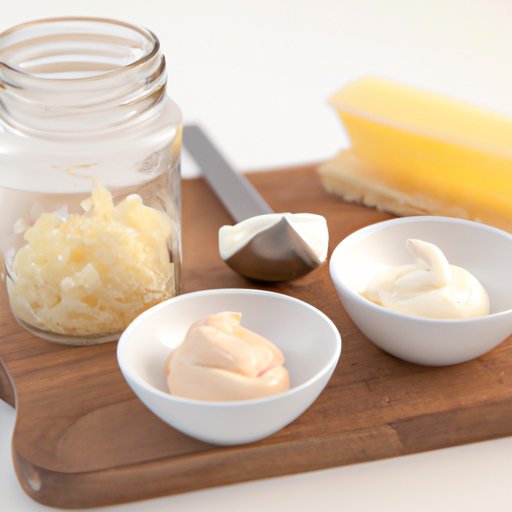I. Introduction
Mayonnaise is a classic condiment that can be used in a variety of dishes, from sandwiches to salads to dips. Learning how to make your own mayonnaise allows you to control the quality of the ingredients and customize the flavor to your liking. In this article, we will provide a step-by-step guide to making traditional mayonnaise, as well as explore variations and healthy alternatives. We will also dive into the history of mayonnaise and compare homemade versus store-bought versions.
II. Step-by-Step Guide
The ingredients for making classic mayonnaise are simple: egg yolks, oil, vinegar or lemon juice, mustard, salt, and sugar. You will need a mixing bowl, whisk, or blender, and a steady hand to add the oil slowly.
Begin by whisking together two large egg yolks, two teaspoons of vinegar or lemon juice, one teaspoon of mustard, half a teaspoon of salt, and a pinch of sugar. Whisk these ingredients together until they are fully combined and begin to thicken.
Next, start adding the oil, drop by drop, while whisking constantly. This step is crucial to ensure that the oil emulsifies with the other ingredients and creates a creamy texture. Once you have added about a quarter cup of oil, you can start adding it in a slow, steady stream while continuing to whisk.
Continue whisking and adding oil until you have used about one cup of oil in total. The mixture should become thick and creamy with a pale yellow color. Taste and adjust seasoning as needed. Your classic mayonnaise is ready!

III. Variations on Classic Mayo
While classic mayonnaise is delicious on its own, you can also experiment with different flavor variations to spice up your dishes. One popular variation is chipotle mayo, which adds a smoky, spicy kick. To make chipotle mayo, mix adobo sauce from a can of chipotle peppers in adobo with your homemade mayonnaise to taste.
Garlic mayo, or aioli, is another tasty variation. Simply mince a clove or two of garlic and mix with your mayonnaise. You can also add lemon juice and herbs such as parsley or chives for a lemon herb mayo.

IV. Healthier Mayonnaise Alternatives
If you are looking for a healthier alternative to regular mayonnaise, there are several options to choose from. Greek yogurt can be a great substitute for mayo in recipes that call for a creamy texture, such as potato salad or coleslaw. Simply mix together yogurt, lemon juice, and seasoning to taste.
Avocado can also be used as a base for a healthier mayo. Mix together mashed avocado, lemon juice, and salt for a simple and flavorful spread. And for a unique twist, try using hummus as a mayo alternative in your sandwiches or wraps.

V. History of Mayonnaise
The origins of mayonnaise are unclear, but it is believed to have originated in France in the 18th century. A popular myth claims that the Duke of Richelieu’s chef created the sauce after the Duke’s victory at the port of Mahon in Menorca, Spain. The sauce was originally called “mahonnaise” and was made from egg yolks, oil, vinegar, and herbs.
Mayonnaise evolved over time and became a staple condiment in French cuisine. It eventually spread to other parts of Europe and the rest of the world. Today, mayonnaise is a popular condiment in many cultures and is used in a variety of dishes.
VI. Comparison of Homemade vs Store-bought Mayonnaise
While store-bought mayo is convenient, it often contains preservatives, artificial flavors, and added sugar. Homemade mayonnaise, on the other hand, allows you to control the quality of the ingredients and avoid these additives.
Homemade mayonnaise also has a fresher taste and smoother texture compared to store-bought versions. Plus, you can customize the flavor to your liking and experiment with different variations.
VII. Conclusion
Learning how to make mayonnaise is a useful skill that can elevate your dishes and give you control over the quality of the ingredients. Whether you choose classic, flavored, or healthy alternatives, homemade mayo allows you to customize your condiments to your liking. And with a rich history and worldwide popularity, mayonnaise is sure to remain a staple in our kitchens for years to come.
